Asian animals include mammals such as the giant panda, tiger, Asiatic lion, snow leopard, orangutan and proboscis monkey; reptiles such as the saltwater crocodile, Indian cobra and Komodo dragon, and birds such as the great hornbill, painted stork and peacock.
On this page is a list of famous (and not-so-famous) Asian animals, with pictures and interesting facts on each species.
Click on an animal's name in the list below to find out more (or continue scrolling to see all of the animals and find out more about Asia).
Asian Animals List
- Asian Elephant
- Asian Golden Cat
- Asian Palm Civet
- Asiatic Black Bear
- Asiatic Brush-Tailed Porcupine
- Asiatic Lion
- Baiji
- Bearcat / Binturong
- Burmese Python
- Clouded Leopard
- Colugos
- Common Krait
- Gaur
- Giant Panda
- Great Hornbill
- Indian Cobra
- Indian Peafowl
- Indian Rhino
- Japanese Macaque
- King Cobra
- Komodo Dragon
- Lar Gibbon
- Malayan Tapir
- Orangutans
- Painted Stork
- Proboscis Monkey
- Przewalski’s Horse
- Red Panda
- Rhesus Macaque
- Saltwater Crocodile
- Sambar
- Slow Loris
- Snow Leopard
- Sun Bear
- Tiger
- Water Buffalo
- Wild Bactrian Camel
- Yak
Discover Amazing Animals From All Around The World
- African Animals
- Antarctic Animals
- Arctic Animals
- Australian Animals
- European Animals
- North American Animals
- South American Animals
What’s your favorite Asian animal? Are there any famous animals that live in Asia that we’ve missed out? Let us know in the comments section at the bottom of the page!
Introduction To Asia
Asia is the world's largest continent. It covers around 30% of Earth’s total landmass.
In some parts of the world, Asia is viewed as being part of a larger continent, Eurasia (along with Europe), rather than being a separate continent.
Being such a large region, Asia contains a wide range of habitats (and a correspondingly diverse range of animals).
Located in Asia are the Himalayas (a mountain range formed when the Indian tectonic plate collided with the Eurasian Plate); the Eurasian Steppe (a vast grassland that stretches from East Europe to East Asia); the deserts of the Middle East; and the tropical rainforests of Southeast Asia.
Asia is home to the greatest number of humans of any continent; around 60% of all humans live in Asia.
The massive expansion in the region's human population has put huge pressure on the animals that live in Asia, and many species in the list below are endangered, usually as a result of habitat loss. The conservation status of each animal has been included.
In the list below we have included not only Asia's iconic animals, but also several lesser-known species, each of which with its own vital role in its respective ecosystem.
Asian Elephant
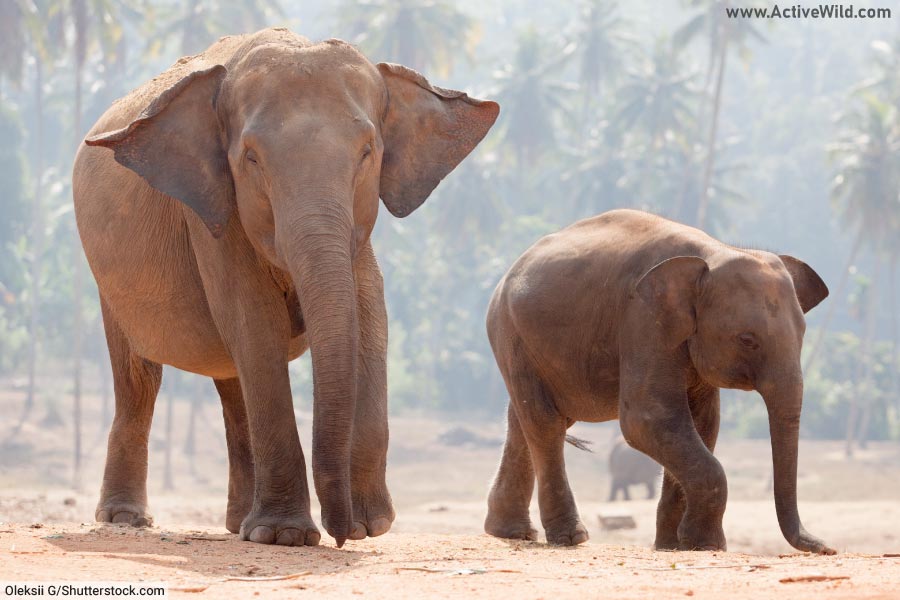
- Scientific name: Elephas maximus
- Type of animal: Mammal
- Family: Elephantidae
- Conservation status: Endangered
The Asian elephant is the largest land animal in Asia. It is found in South and Southeast Asia, where it inhabits forests, shrublands and grasslands.
Female Asian elephants live in herds, while adult males tend to be more solitary. The typical lifespan of an Asian elephant is 60-70 years.
The Asian elephant is one of three living animals in the family Elephantidae (the others being the African bush elephant and the African forest elephant).
Unlike African elephants, female Asian elephants lack tusks.
The Asian elephant is endangered due mainly to habitat loss and poaching. Male Asian elephants are targeted for their ivory, while elephants of both sexes are targeted for use in traditional Asian medicine.
You can find out more about elephants on this page: Fun Facts on Elephants
Asian Golden Cat

- Scientific name: Catopuma temminckii
- Type of animal: Mammal
- Family: Felidae
- Conservation status: Near Threatened
The Asian, or Asiatic golden cat, is a wild cat found in South and Southeast Asia, including parts of India, Bangladesh, China, Thailand and Malaysia. The species is present on the island of Sumatra.
The Asian golden cat is primarily a forest animal, but is also occasionally seen in savannas and grasslands. It is a mid-sized species, around two or three times the size of a domestic cat. As its name suggests, the Asian golden cat has a golden-brown coat. Its face has distinctive light and dark markings.
The golden cat is threatened by deforestation, which is still occurring throughout much of Asia. The species is currently rated “Near Threatened” by the IUCN.
You can see pictures and facts on ALL wild cat species on this page: Wild Cats List
Asian Palm Civet

- Scientific name: Paradoxurus hermaphroditus
- Type of animal: Mammal
- Family: Viverridae
- Conservation status: Least Concern
The Asian palm civet is a viverrid – a member of the family Viverridae, which also includes several other civets, as well animals such as genets and the binturong.
Viverrids belong to the suborder Feliformia – a group of carnivores that are more closely related to cats than they are to dogs.
Although primarily a forest animal, the Asian palm civet is able to live in a wide range of habitats, including alongside humans in urban environments. The species is often present in parks and gardens.
The Asian palm civet’s droppings, which often contain the digested remains of coffee fruits, are used to make Kopi luwak – a variety of coffee. Sadly, the Asian palm civet is now being intensively farmed for the manufacture of this product.
Asiatic Black Bear
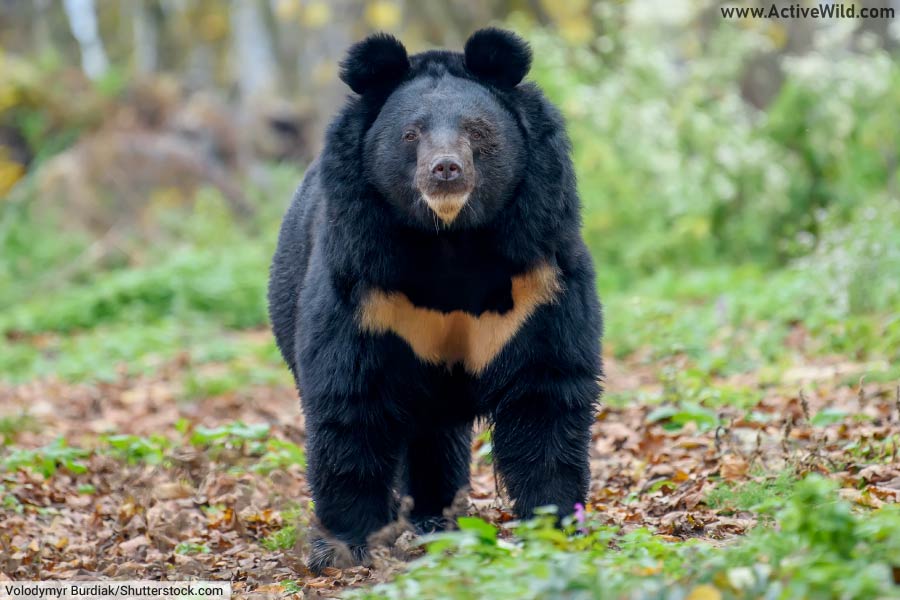
- Scientific name: Ursus thibetanus
- Type of animal: Bear
- Family: Ursidae (the bear family)
- Conservation status: Vulnerable
The Asiatic, or Asian black bear, is found in many parts of Asia. It is a capable climber and spends much of its life in the trees. It is a close relative of the American black bear (Ursus americanus), and, apart from the distinctive V-shaped white patch on the Asian species’ chest, the two are very similar in appearance.
The Asian black bear is one of the eight living species of bear. Together they make up the family Ursidae (individual members of which are known as ‘ursids’).
Although primarily herbivorous, the Asian black bear is known for its aggression, and will attack humans without warning.
You can find out more about this Asian animal on this page: Asiatic Black Bear Facts
Asiatic Brush-Tailed Porcupine

- Scientific name: Atherurus macrourus
- Type of animal: Mammal (rodent)
- Family: Hystricidae
- Conservation status: Least Concern
The Asiatic brush-tailed porcupine belongs to the old world porcupine family, Hystricidae. Hystricidae is one of two porcupine families, the other being Erethizontidae – the new world porcupines.
Despite similarities in appearance, the old and new world porcupines are not closely related.
The Asiatic brush-tailed porcupine is found in forests and shrublands across much of Southeast Asia. It is a nocturnal, burrowing animal.
You can find out more about porcupines on this page: Porcupine Facts
Asiatic Lion

- Scientific name: Panthera leo leo
- Type of animal: Mammal
- Family: Felidae
- Conservation status: Vulnerable
“Asiatic lion” is the name given to a small population of lions found in India. Asiatic lions are not only the only lions present in Asia, but also the only lions found in the wild outside of Africa. Their population currently numbers around 700 individuals.
Once found across a much wider area of Asia, including the Middle East, Asiatic lions today are found only in the Indian state of Gujarat. Here, they live in the relative safety of the Gir National Park, a wildlife sanctuary founded specially to protect the Asian lion population.
You can find out more about lions on this page: Lion Facts
Baiji
(No image available)
- Scientific name: Lipotes vexillifer
- Type of animal: Mammal
- Family: Lipotidae
- Conservation status: Critically Endangered (Possibly Extinct)
The Baiji is a freshwater dolphin once found in the Yangtze River of China. The species is also known as the Yangtze River dolphin.
(The Yangtze River is the longest river in Asia, the third-longest river in the world, and the longest river to flow through a single country.)
No baiji has been seen for over a decade, and the species is now believed to be extinct.
The species was a victim of the rapid industrialization of China, its natural habitat having been degraded by pollution, the building of structures such as dams, and increased human use of the Yangtze River. The species was also frequently caught as bycatch by fishermen targeting other species.
Binturong / Bearcat
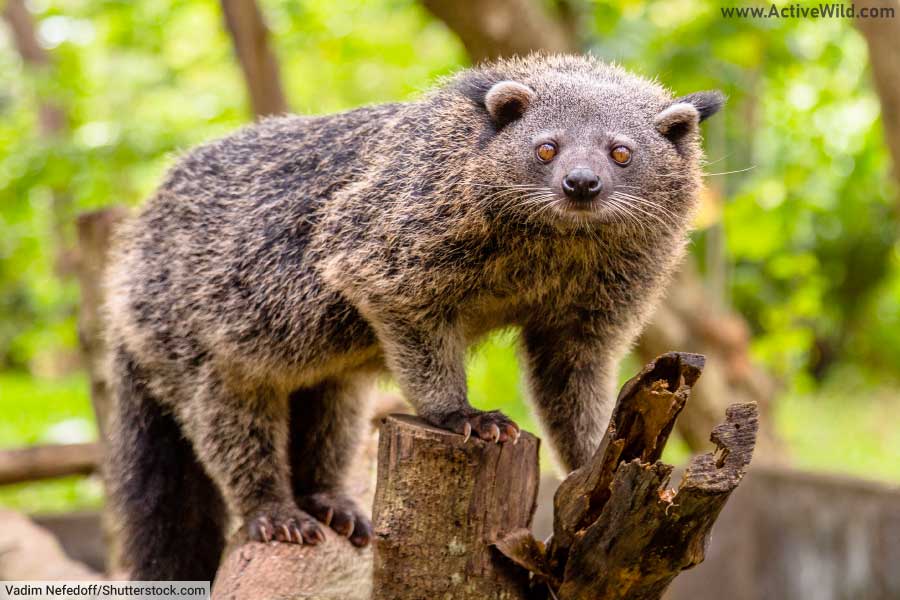
- Scientific name: Arctictis binturong
- Type of animal: Mammal
- Family: Viverridae
- Conservation status: Vulnerable
The binturong (also known as a bearcat) – is the largest member of the animal family Viverridae. (Members of this family are known as viverrids). It is found in the forests of South and Southeast Asia.
The binturong’s long tail is “prehensile”, which means that it is capable of holding onto things. The binturong uses its tail as an “extra hand” while climbing.
The binturong is the only Old World mammal with a prehensile tail.
This Asian animal has a “Vulnerable” conservation status, due to habitat loss and from being hunted for its meat and skin.
You can find out more about the binturong on this page: Binturong Facts
Burmese Python

- Scientific name: Python bivittatus
- Type of animal: Reptile
- Family: Pythonidae
- Conservation status: Vulnerable
The Burmese python is a large snake found in rainforests, mangroves and other habitats in southeast Asia. A small population of Burmese pythons is also found in the Florida Everglades.
Reaching a recorded length of up to 5.74 m / 18 ft 10 in, and possibly growing even longer, the Burmese python is the world’s second-heaviest snake (after the green anaconda).
The Burmese python is a member of the python family, Pythonidae. Like other pythons, it is non-venomous, subduing its prey by constriction rather than by envenomation.
Active during the day, the Burmese python is a capable climber and swimmer.
Click here to find out more about snakes
Click here to discover different types of snakes
Clouded Leopard

- Scientific name: Neofelis nebulosa
- Type of animal: Mammal
- Family: Felidae
- Conservation status: Vulnerable
The clouded leopard is a member of the subfamily Pantherinae, which is a subgroup of the cat family, Felidae. With a nose-tail length of around 1.65m, the clouded leopard is mid-way in size between the small cats and big cats such as lions and tigers.
This Asian animal gets its name from the cloud-like markings on its coat. It is known as the “modern-day saber-tooth” due to the length of its canine teeth.
Equipped with flexible ankles and strong, sharp claws, the clouded leopard is an expert climber. It can hang from branches and even climb down tree trunks head first.
You can find out more about the clouded leopard on this page: Clouded Leopard Facts
Colugos
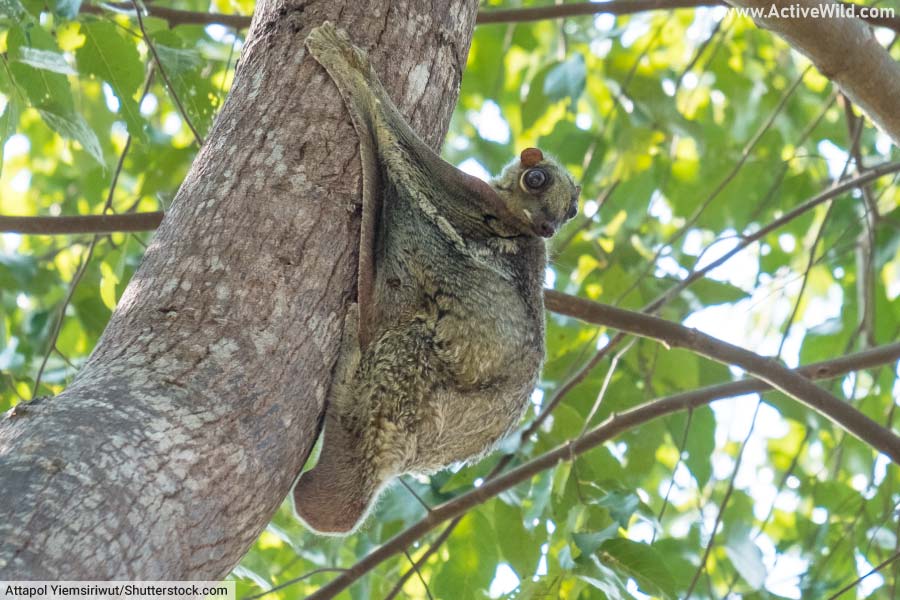
- Class: Mammalia
- Order: Dermoptera
Colugos are a group of mammals in the order Dermoptera. Found in Southeast Asia, there are only two extant (living) species: the Sunda flying lemur Galeopterus variegatus and the Philippine flying lemur Cynocephalus volans.
Despite their names, neither are lemurs (colugos are not primates), nor can they fly. Instead, they glide, using a fur-covered membrane known as a patagium as a wing. In this way, colugos can travel up to 70 meters through the canopy.
These arboreal (tree-dwelling) Asian animals are mostly active at night, when they forage for soft flowers and fruits.
Also known as the Malayan colugo, the Sunda flying lemur is reasonably adaptable in its choice of habitat types. Its conservation status is Least Concern. However, with current rates of deforestation, its population is declining.
Known locally as Kagwang, the Philippine flying lemur is found across the Philippines. This species lives in lowland primary and secondary rainforests. Its conservation status is Least Concern, with populations remaining stable across the region.
Common Krait

- Scientific name: Bungarus ceylonicus
- Type of animal: Reptile
- Family: Elapidae
- Conservation status: Near Threatened
The common krait is a species of snake found on the Indian subcontinent. This Asian reptile is a member of a group of highly venomous snakes known as the “Big Four”. These snakes are responsible for a large proportion of serious snake bites in Southeast Asia.
A bite from a common krait can cause respiratory failure in humans. Unfortunately, due to habitat loss, humans and common kraits are being brought into more frequent contact.
The common krait most active at night. It is found in a range of habitats, including forests, plantations and gardens.
The species is dark brown / black with pale stripes, and is known to reach lengths of nearly 1.8 meters – approximately as long as a fully grown man is tall.
The common krait feeds predominately on other snakes, with cannibalization not out of the question. Small vertebrates, such as rodents and lizards, are also on the menu.
Click here to find out more about snakes
Click here to discover different types of snakes
Gaur
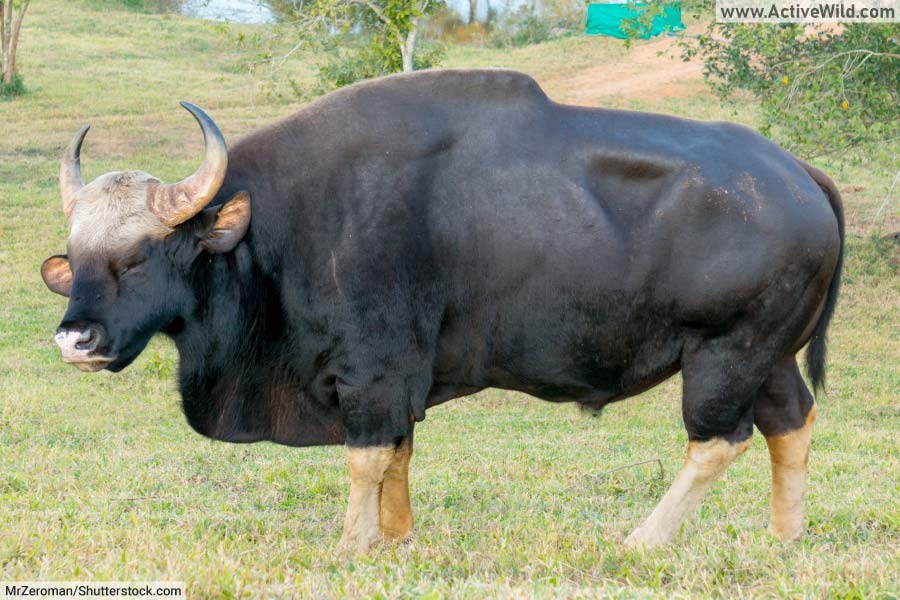
- Scientific name: Bos gaurus
- Type of animal: Mammal
- Family: Bovidae
- Conservation status: Vulnerable
A member of the same animal family as the domesticated cow, the guar is a wild bovid found in the forests of South and Southeast Asia.
Since 1986, the guar has been listed on the IUCN Red List as Vulnerable. In 2016, its wild population was estimated to contain only between 6000 and 21000 mature individuals; a decrease of some 70% since the 1960’s.
Today, the guar is internationally protected and numbers are on the rise in some National Parks.
Guars are the largest of all extant wild bovids. Adult males can reach weights of over 1500kg, just slightly larger than females. Both sexes have curved horns that can reach 115cm in length.
Due to habitat fragmentation, the species’ historic range has been greatly reduced. Today, the gaur is confined to evergreen forests and moist deciduous forests. Its diet consists of grass, bamboo and shrubs.
Giant Panda
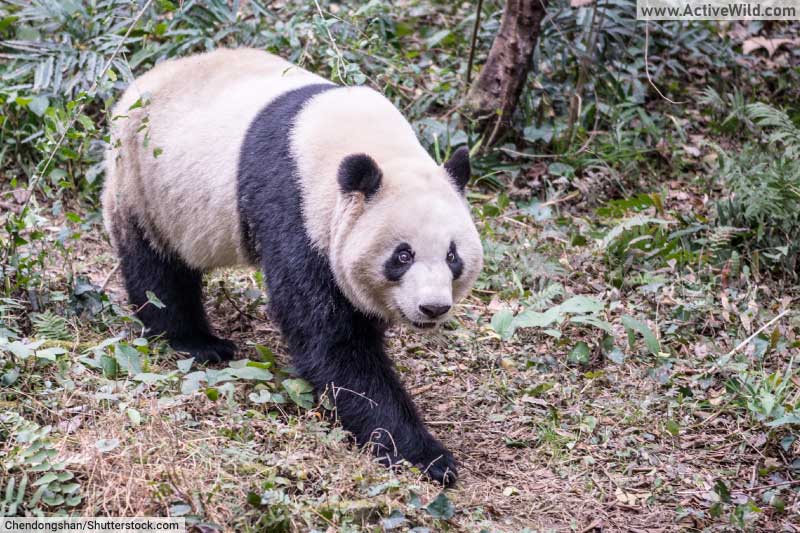
- Scientific name: Ailuropoda melanoleuca
- Type of animal: Mammal
- Family: Ursidae
- Conservation status: Vulnerable
With its iconic black and white coat, the giant panda is one of the most famous of all Asian animals. The panda (the “giant” part of its name is often omitted) is a member of the bear family, Ursidae.
Unlike other ursids (members of the bear family), the panda is an obligate herbivore; it must eat plants in order to survive. The majority of its diet consists of bamboo; the panda can eat up to 14kg of the tough grass in a single day.
The giant panda has a digestive system similar to that of other, more carnivorous, bear species. As a result, it derives little in the way of nutrition from the bamboo it eats.
This means that the giant panda is required to limit its energy expenditure throughout the day. Another side effect of the largely grass diet is excessive defecation; giant pandas can poop up to 40 times a day.
Found in the temperate forests in Southwestern China, the panda resides on mountainous terrain between 1000-4000 meters in altitude.
The giant panda’s conservation status was recently changed from “Endangered” to “Vulnerable”, and the species’ population is on the rise.
Despite this, habitat loss due to developing human infrastructure still threatens the species.
You can find out more about the giant panda on this page: Panda Facts
Great Hornbill

- Scientific name: Buceros bicornis
- Type of animal: Bird
- Family: Bucerotidae
- Conservation status: Vulnerable
The great hornbill is a member of the hornbill family, Bucerotidae. With a wingspan of around 1.5m, the great hornbill is one of the larger hornbill species. It is found across Southeast Asia and the Indian subcontinent.
Hornbills are known for their large, downwardly-curving bills, but that of the great hornbill is particularly striking, being a bright orange-yellow color. On top of the huge bill is a large casque (a bony growth), which is also yellow-orange.
Both male and female great hornbills have casques. The exact purpose of the structure is unknown; males fight by hitting their casques together while flying, and it is likely the casque plays a part in selecting / obtaining a mate.
The great hornbill’s huge, brightly-colored bill and casque, together with its large size and yellow throat feathers, make the species one of Asia’s most distinctive birds.
Like other hornbills, the great hornbill has eyelash-like feathers that serve both to protect the eye from particles when the bird is in flight, and to shield the eye from the sun.
The great hornbill is a relatively long-lived species, with a lifespan of up to 20 years in the wild. It is primarily frugivorous (fruit-eating), but will supplement its diet with small vertebrates from time to time.
Indian Cobra

- Scientific name: Naja naja
- Type of animal: Reptile
- Family: Elapidae
- Conservation status: Least Concern
The Indian cobra (also known as the Asian cobra) is one of Asia’s “Big Four” – a group of venomous snakes that are responsible for the most snake bites in Southeast Asia. (The other members of the big four are the common krait, Russell’s viper, and saw-scaled viper.)
The Indian cobra is famous for being the species of snake used in the performances of traditional Indian snake charmers. In the wild, the species is found in a variety of habitats, including forests, shrublands and rice paddies.
Most Indian cobras are between 1 and 1.5 meters in length. Exceptionally long specimens can reach lengths of over 2m. When threatened, the Indian cobra rears up and expands its hood.
The species is responsible for around 15,000 human deaths each year.
Click here to find out more about snakes
Click here to discover different types of snakes
Indian Peafowl

- Scientific name: Pavo cristatus
- Type of animal: Bird
- Family: Phasianidae
- Conservation status: Least Concern
The Indian peafowl is native to the Indian subcontinent, and the species is the national bird of India. Male peafowl are known as “peacocks”; females as “peahens”.
Due to the peacock’s spectacularly colorful display feathers (which are known as its “train”), the species has been introduced by humans to just about every corner of the globe.
Another reason for the bird’s popularity in India is its habit of preying on venomous cobras.
A peacock’s train consists of over two-hundred feathers, which are lifted to create a fan-like display in order to attract females. The feathers are marked with eyespots known as ocelli.
Strictly speaking, the display feathers are not the peacock’s tail, but its uppertail coverts (coverts are feathers that cover other feathers).
The peacock’s display feathers are molted and regrown every year.
Indian Rhino
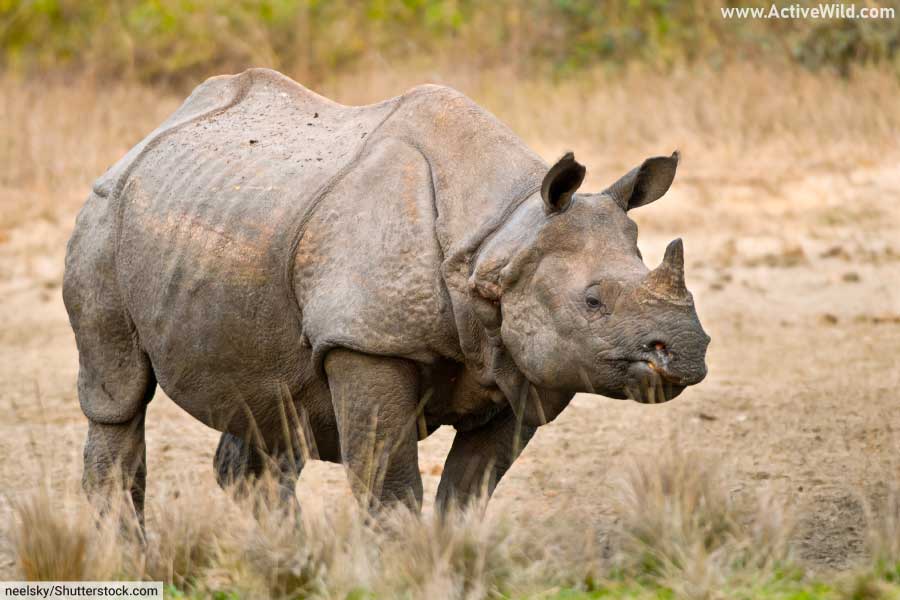
- Scientific name: Rhinoceros unicornis
- Type of animal: Mammal
- Family: Rhinocerotidae
- Conservation status: Vulnerable
The Indian rhinoceros is the second-largest land animal in Asia; only the Asian elephant is larger. It is the second-largest rhino species, after the white rhinoceros. Male Indian rhinos can reach weights of up to 2200kg; females weigh significantly less, averaging 1600kg.
Of the five living rhino species, three are found in Asia. The Indian rhino is the only Asian rhino found on the mainland; the Sumatran rhino is found on the islands of Sumatra and Borneo, while the Javan rhino is found on Java.
The Indian rhino, like the closely-related (and critically endangered) Javan rhino, has only a single horn on its snout. (The two African rhino species (the white rhino and black rhino), and the Sumatran rhino have two horns.)
Indian rhinoceroses of both sexes have a horn, which reach lengths of around 30cm – significantly less than the horns of their African cousins, which can reach lengths of up to 140cm. The horn itself is made from keratin, the same natural substance from which our fingernails are made.
Classified as Vulnerable by the IUCN, the Indian rhino is threatened by both poaching and habitat loss. Its numbers appear to be slowly on the rise, thanks to dedicated conservation work.
The Indian rhino is found in forested areas, wetlands and grasslands. A grazer, its diet consists mainly of grass, which it supplements with other vegetable matter such as leaves, and fruit.
You can find out more about rhinos on this page rhino facts
Japanese Macaque
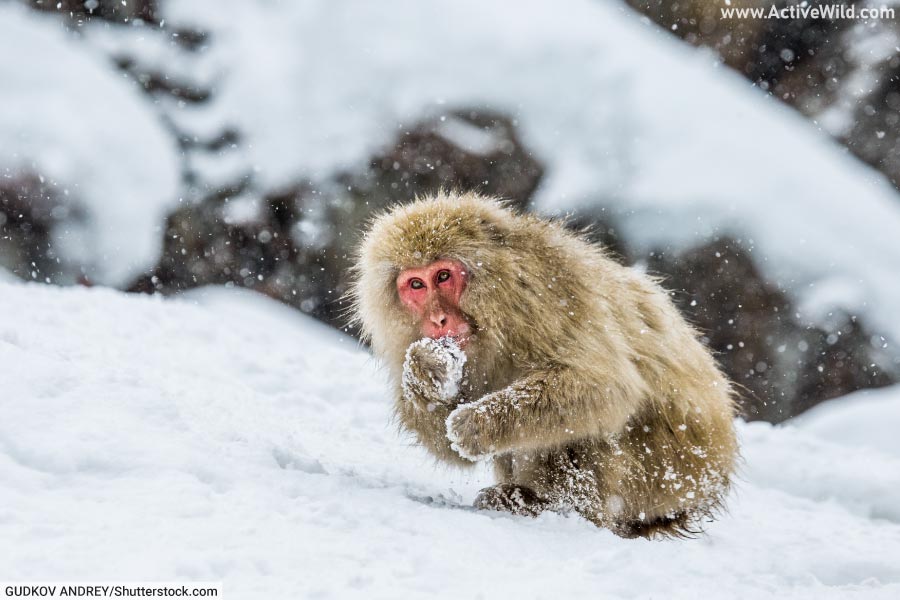
- Scientific name: Macaca fuscata
- Type of animal: Mammal
- Family: Cercopithecidae
- Conservation status: Least Concern
Also known as the snow monkey, the Japanese macaque is found in cold, mountainous regions of Japan, some of which are covered in snow for much of the year.
No other primate (other than man) lives in a colder climate. Due to its thick fur, this Asian monkey can survive temperatures as low as -20°C. It is found further north than any other non-human primate.
The Japanese macaque has a distinctive pink face. The redder the face, the older the individual. The color of the face becomes more vibrant during mating season. Baby Japanese macaques have brown, hairless faces.
The Japanese macaque is sexually dimorphic (males and females differ in size or appearance), with males weighing 11kg and females average around 8kg.
Present on three of the five main islands of Japan (Honshu, Shikoku, and Kyushu), the Japanese macaque has a stable population. It is found in a variety of habitats, ranging from subtropical forests to subarctic forests.
Japanese macaques in the Jigokudani Monkey Park are famous for their behavior of bathing communally in the hot springs present in the park.
You can find out more about monkeys on this page: Monkeys: The Ultimate Guide
King Cobra
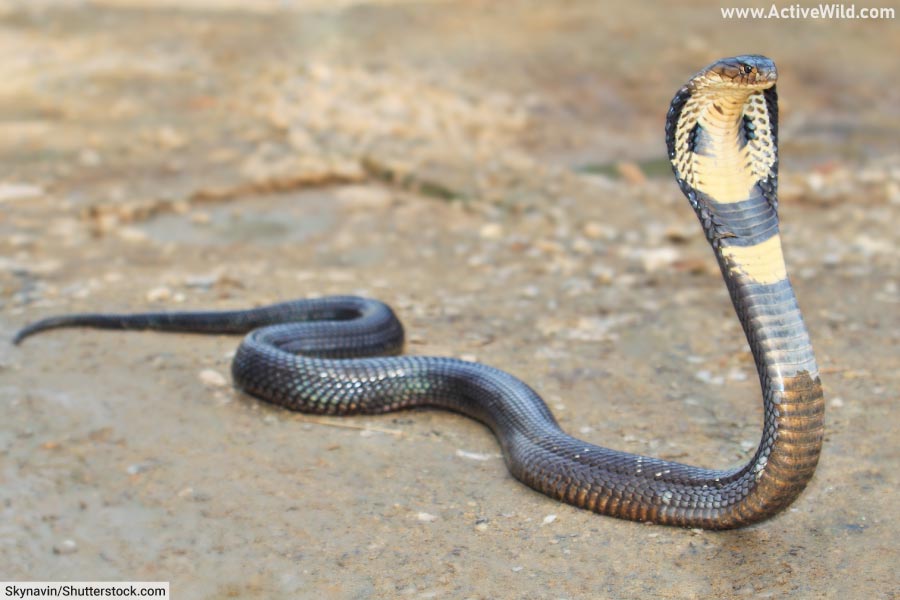
- Scientific name: Ophiophagus hannah
- Type of animal: Reptile
- Family: Elapidae
- Conservation status: Vulnerable
The king cobra is a venomous snake found across South and Southeastern Asia. It is the only surviving member of the genus Ophiophagus.
Like all elapids (members of the family Elapidae), the king cobra has permanently erect fangs.
The king cobra can reach lengths of up to 5.8 meters, and is the world’s longest venomous snake.
When threatened, the king cobra will rear up, often to the height of an adult human, and spread its neck flaps to appear more intimidating. Despite its fearsome reputation, the king cobra is relatively docile, preferring to avoid confrontation wherever possible.
The king cobra can be found in a variety of habitat types, including primary forests, felled forests, plantations and mangroves. It is the only snake species that builds its nest from leaf litter.
The king cobra preys mainly on other snakes, and will cannibalize other king cobras.
Click here to find out more about snakes
Click here to discover different types of snakes
Komodo Dragon
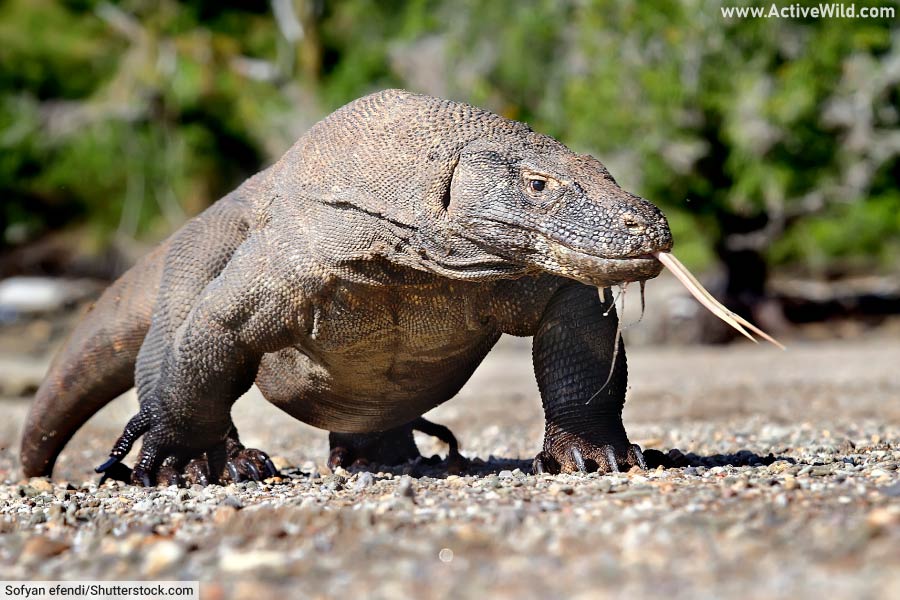
- Scientific name: Varanus komodoensis
- Type of animal: Reptile
- Family: Varanidae
- Conservation status: Endangered
The Komodo dragon is a member of the monitor lizard family, Varanidae. It is found on just four Indonesian islands: Komodo, Rinca, Flores and Gili Motang.
The Komodo dragon is the world’s largest extant lizard species, reaching sizes of up to 3 meters, and weighing up to 70kg.
this giant Asian reptile is an obligate carnivore (it needs to eat meat to survive). It feeds on a variety of prey, including deer, boar, goats, invertebrates and other Komodo dragons. It will also consume carrion.
The Komodo dragon has an incredibly powerful tail, which it uses as a weapon, both when hunting and when competing against other males for females and while defending its territory. It is an ambush hunter, lying in wait before rushing its prey.
The saliva of the Komodo dragon was once thought to contain toxic bacteria. Today, many zoologists believe that the Komodo dragon may instead be slightly venomous.
The Komodo dragon lives in forest and savanna habitats. Its population is severely fragmented. Climate change and agriculture are thought to pose the biggest risk to the survival of this species.
You can find out more about the Komodo dragon on this page: Komodo dragon facts
Lar Gibbon
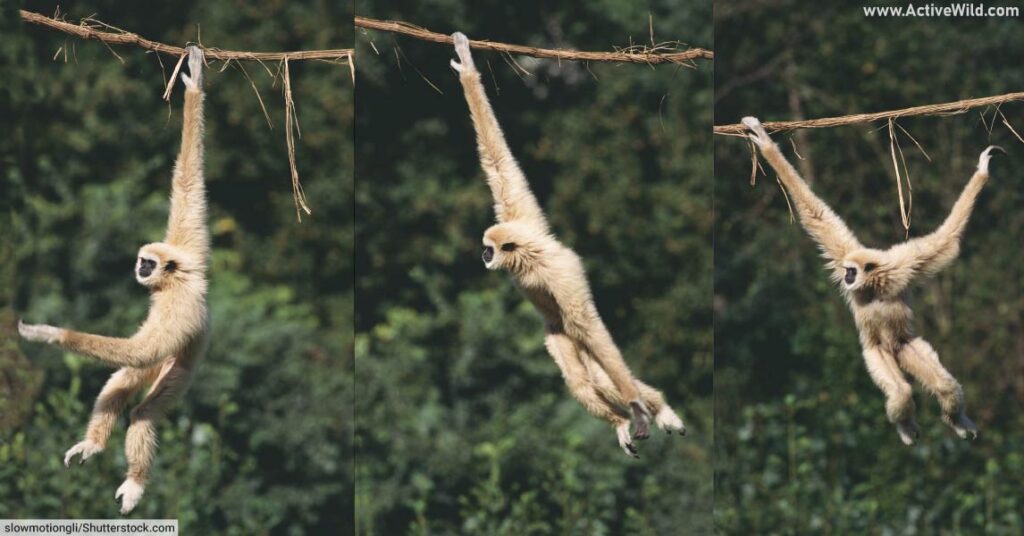
- Scientific name: Hylobates lar
- Type of animal: Mammal
- Family: Hylobatidae
- Conservation status: Endangered
The lar gibbon is an endangered species of primate found in rainforests across South and Southeast Asia. The coloration of its fur varies greatly, ranging from black to tan. The species is also known as the “white-handed gibbon” on behalf of its white hands and feet.
Like other gibbons, the Lar gibbon uses its long, flexible arms to swing from branch to branch – a means of locomotion known as brachiation. A lar gibbon can travel up to 12 meters in a single swing. Elongated fingers help the gibbon to grip onto the branches.
The lar gibbon is mainly frugivorous (fruit-eating). It will also consume insects, flowers and leaves.
Deforestation and habitat fragmentation are the leading cause for the decline in lar gibbon populations.
You can find out more about primates on this page: Primate Facts
Malayan Tapir

- Scientific name: Tapirus indicus
- Type of animal: Mammal
- Family: Tapiridae
- Conservation status: Endangered
The Malayan tapir is a large, ground-dwelling mammal in the order Perissodactyla, the same order of hoofed mammals to which horses and rhinos belong.
The Malayan tapir is the largest of the four species of tapir, weighing up to 350kg, and reaching lengths of up to 1.8 meters.
The species has a distinct black and white block coloration, which helps it blend into the dark understory of its rainforest habitat. It is found throughout the Malayan peninsula and into Thailand and Myanmar. It has also been recorded on the island of Sumatra.
The main natural predators of the Malayan tapir are tigers and dholes (a species of wild dog).
Sadly, humans are responsible for the Malayan tapir’s Endangered status. The species is often hunted for bushmeat, and habitat loss is another cause of the tapir’s declining population.
You can find out more about tapirs on this page: Tapir Facts
Orangutans

- Class: Mammalia
- Order: Primates
- Conservation status: Critically Endangered
The three species of orangutan are members of the family Hominidae, a group of highly intelligent primates also known as “great apes”. Humans also belong to this family, and we share over 96% of our genes with orangutans.
Orangutans are the largest living tree-dwelling mammals. All three species of orangutan are critically endangered.
- The Sumatran orangutan lives throughout the moist lowland forests of Sumatra. It is exclusively arboreal, seldom coming down to the forest floor. The species has longer facial hair than other orangutan species. It is thought that there are fewer than 14,000 Sumatran orangutans remaining in the wild.
- The Bornean orangutan can be found in tropical moist lowlands across the island of Borneo. Unlike the Sumatran orangutan, it is known to travel on the ground as well as in the trees.
- The Tapanuli orangutan is a recently discovered species of orangutan. It is found in a very condensed pocket of Sumatra, and its population is thought to consist of fewer than 800 individuals.
You can find out more about orangutans on this page: Orangutan Facts
Painted Stork
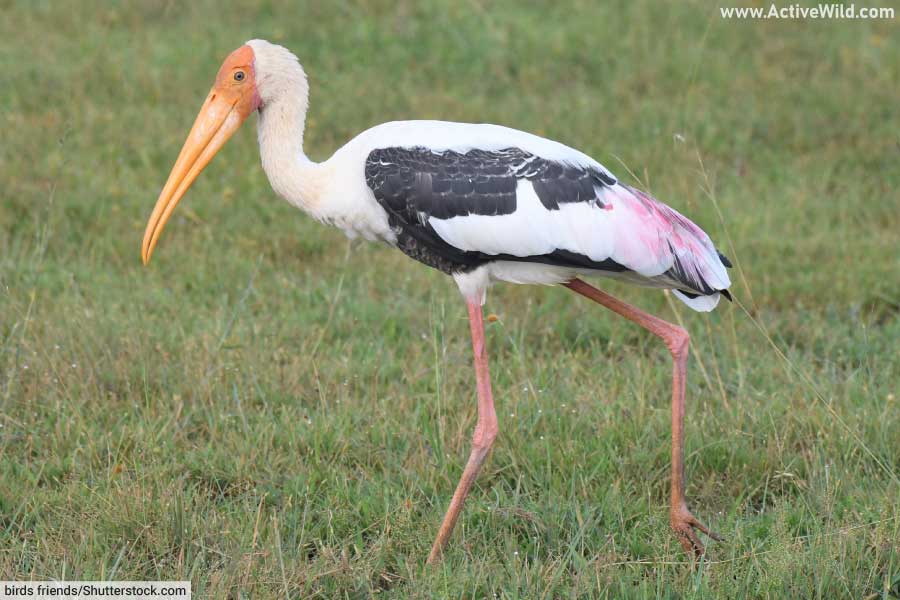
- Scientific name: Mycteria leucocephala
- Type of animal: Bird
- Family: Ciconiidae
- Conservation status: Near Threatened
The painted stork is a member of the stork family Ciconiidae found south of the Himalayas and into Southeast Asia. Like all storks, it is a large, long-legged bird with a long and sturdy bill.
A distinctive feature of the painted stork is the pink shade of its flight feathers (it’s this feature that gives the species its name).
The painted stork is a wetland bird, inhabiting marshes, lakes and other freshwater habitats in tropical Asia. A carnivore, it feeds by sweeping its long beak from side to side through the water, grabbing small fish and other vertebrates disturbed by its feet.
Young painted storks call loudly, but in adulthood the species is practically silent, besides the clapping of its beak.
Unlike many storks, painted storks are non-migratory. The species nests colonially in trees along shallow riverbeds, often with other waterbirds.
Proboscis Monkey
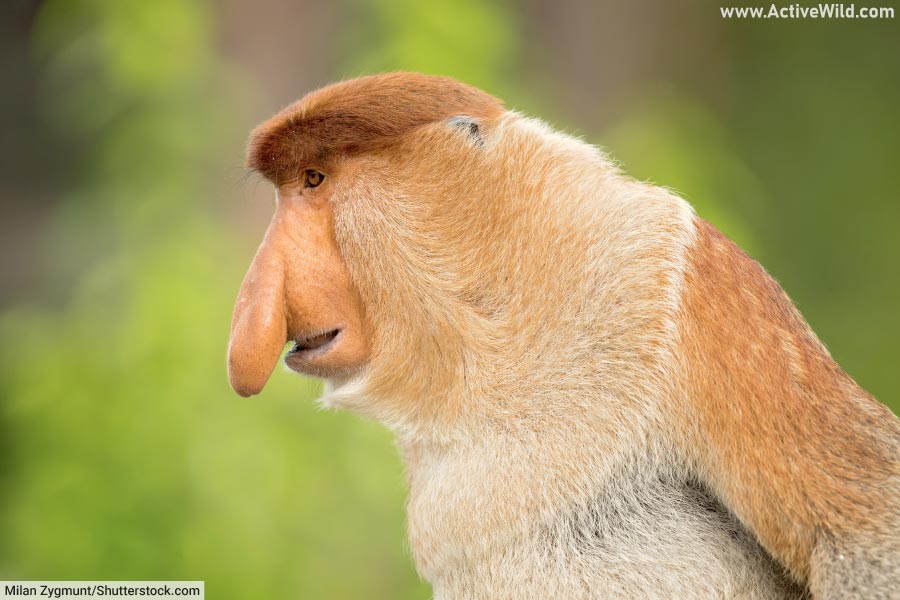
- Scientific name: Nasalis larvatus
- Type of animal: Mammal
- Family: Cercopithecidae
- Conservation status: Endangered
The proboscis monkey is an endangered primate found only on the island of Borneo, and is one of the largest monkeys found in Asia. It inhabits forests near rivers and mangrove forests (coastal forests that are waterlogged). The species is strongly associated with water, and even has webbed toes for swimming – a skill that it uses to evade predators.
The long, fleshy nose of the male proboscis monkey serves to amplify its call, with females seemingly favoring males with louder calls.
With a decreasing population currently thought to number fewer than 7,000 individuals, the proboscis monkey is an endangered species. This is due mainly to deforestation.
Like many primates, the proboscis monkey is highly vocal. It will honk to warn the troop of predators, and shriek to express agitation or excitement.
You can find out more about the proboscis monkey on this page: Proboscis Monkey Facts
Przewalski’s Horse
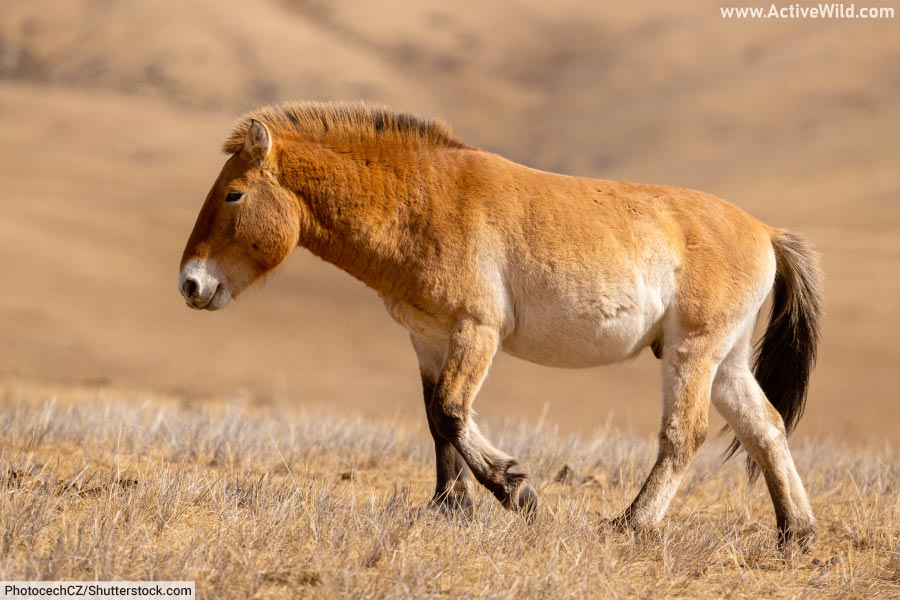
- Scientific name: Equus ferus przewalskii
- Type of animal: Mammal
- Family: Equidae
- Conservation status: Endangered
Przewalski’s horse is a species of wild horse that lives on the grasslands of China and Mongolia. The region in which it is found is part of the Eurasian Steppe, a vast area of grasslands and savannas that stretches from Eastern Europe to eastern Asia.
Przewalski’s horse became extinct in the wild in the mid-20th century. A captive breeding program allowed it to be reintroduced into several areas in the 1990’s. Today, the species has a wild population numbering several hundred.
While other wild horses, such as the closely-related zebra, often live in large herds, Przewalski’s horse tends to live in a much smaller groups, containing around 6-8 adults.
Przewalski’s horse has been successfully introduced into the Chernobyl exclusion zone in Ukraine, which has become a haven for wildlife since the Chernobyl disaster in 1986.
The species was named after Russian explorer Nikolay Przewalski (see Wikipedia), who introduced the subspecies to western science.
You can find out more about Przewalski’s horse on this page: Przewalski’s Horse Facts
Red Panda

- Scientific name: Ailurus fulgens
- Type of animal: Mammal
- Family: Ailuridae
- Conservation status: Endangered
The red panda, despite its name, is not related to the giant panda. Neither is this Asian animal a member of the bear family, Ursidae.
In fact, the red panda is the only living member of the family Ailuridae. Its closest relative is the raccoon (which is a member of the family Procyonidae).
Although not related to the giant panda, the red panda shares some similarities with its ursid namesake. The diet of both Asian animals consists mainly of bamboo, and both animals have an extended wrist bone, or false thumb, which is an adaptation for eating the tough grass.
The red panda is found in the montane forests of the Eastern Himalayas, and is present in Bhutan, China, India, Myanmar and Nepal. It is arboreal (tree-dwelling) and lives along outside of the mating season.
An endangered species, the red panda is threatened primarily by deforestation caused by the expansion of human settlements and creation of crop plantations.
The species’ wild population consists of around 9,000 individuals, and is thought to be decreasing.
You can find out more about the red panda on this page: Red Panda Facts
Rhesus Macaque / Common Macaque

- Scientific name: Macaca mulatta
- Type of animal: Mammal
- Family: Cercopithecidae
- Conservation status: Least Concern
The rhesus macaque is a primate belonging to the old-world monkey family, Cercopithecidae. It is one of 23 species of genus Macaca – a group of monkeys known as macaques.
The Rhesus macaques is common and extremely widespread; it is found across much of southern Asia and inhabits a larger area than any other primate apart from man.
In addition to its natural range, the rhesus macaque has been introduced in the United States, and populations exist in both Florida and Morgan Island, South Carolina.
Due to similarities between the rhesus monkey and humans, the species is commonly used in medical research.
The rhesus macaque lives in troops of 20 to 200 individuals, which consist mainly of females; males leave the group after reaching adulthood.
Saltwater Crocodile
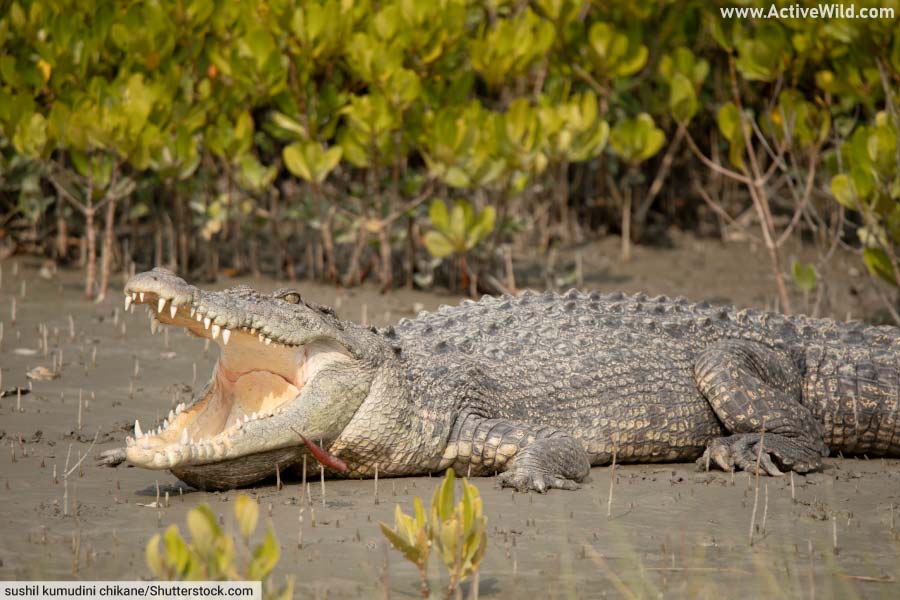
- Scientific name: Crocodylus porosus
- Type of animal: Reptile
- Family: Crocodylidae
- Conservation status: Least Concern
The saltwater crocodile is both the world’s largest living reptile and the world’s largest land predator. It is found in coastal areas of South and Southeast Asia, New Guinea and Australia.
Male saltwater crocodiels can reach lengths of over 6 m / 20 ft, and weigh up to 1,300 kg / 2,900 lb. They are significantly larger than the females.
Like other crocodiles, the saltwater crocodile is an ambush predator that lies submerged in the water waiting for prey to come within range of its powerful jaws.
The saltwater crocodile, due to its size, power and ferocity, is an extremely dangerous animal and areas in which it is found are best avoided.
With a population estimated to number around 500,000, the saltwater crocodile’s conservation status is “Least Concern”.
You can find out more about the saltwater crocodile on this page: Saltwater Crocodile Facts
Sambar
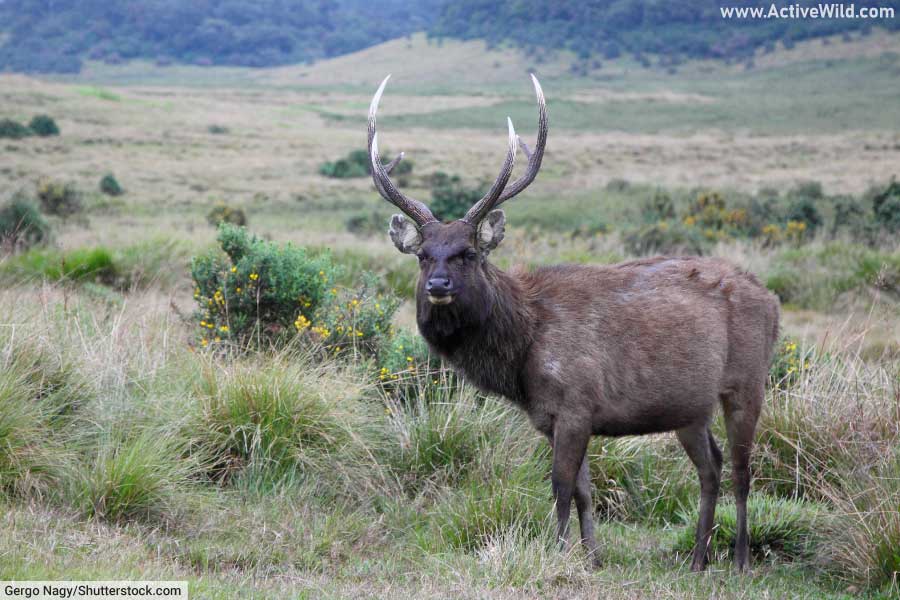
- Scientific name: Rusa unicolor
- Type of animal: Mammal
- Family: Cervidae
- Conservation status: Vulnerable
The sambar is the third-largest member of the deer family, Cervidae; only the moose and elk are larger. It is found across a wide range in South and Southeastern Asia.
Predominantly a forest animal, the adaptable sambar is also known to inhabit shrublands, grasslands and wetlands.
This large Asian mammal is crepuscular (active at dawn and dusk). Males are solitary outside of the mating season, while females live in small herds.
The sambar faces an array of formidable predators; it is a favorite quarry of tigers, and is also targeted by leopards, Asiatic lions, dholes, and crocodiles.
Slow Loris
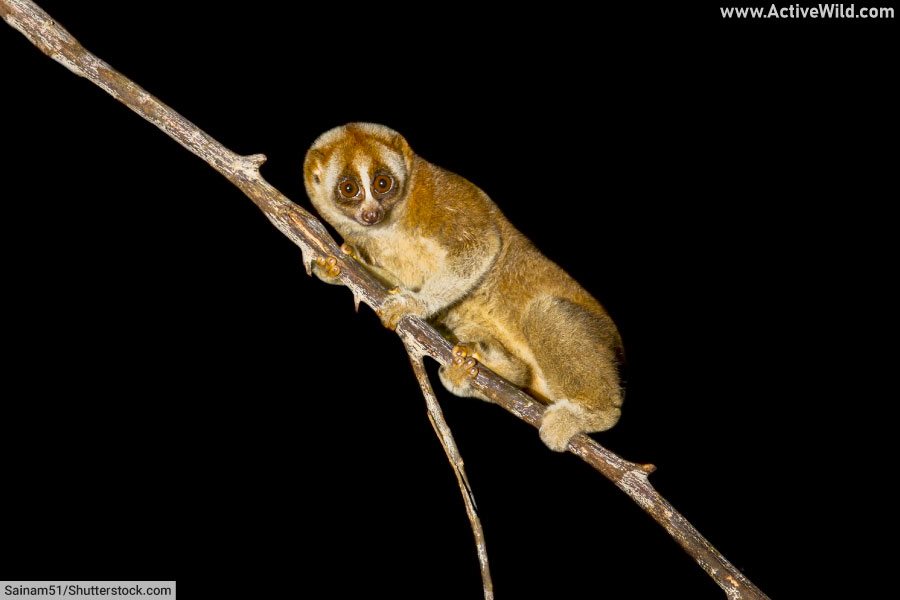
- Type of animal: Mammal
- Family: Lorisidae
The slow lorises are a group of primates of genus Nycticebus. There are eight species of slow loris. Their closest relatives in the animal kingdom are the two species of slender loris; together, the lorises make up the subfamily Lorinae.
Slow lorises are small animals with short, wooly hair and large eyes. As their name suggests, they are slow-moving animals, typically moving through the trees quietly and deliberately, and freezing if they think they have been spotted.
Thanks to the unique design of their hands, slow lorises can grasp onto branches extremely tightly while expending little energy.
These Asian primates have two tongues: a main tongue is long and thin for reaching nectar in flowers, and a short additional tongue located under the first for cleaning their sharp, comb-like lower teeth.
Slow lorises are unique among primates for having a toxic bite. The toxins are produced when the loris mixes chemicals produced by a gland on its arm with its saliva.
Snow Leopard
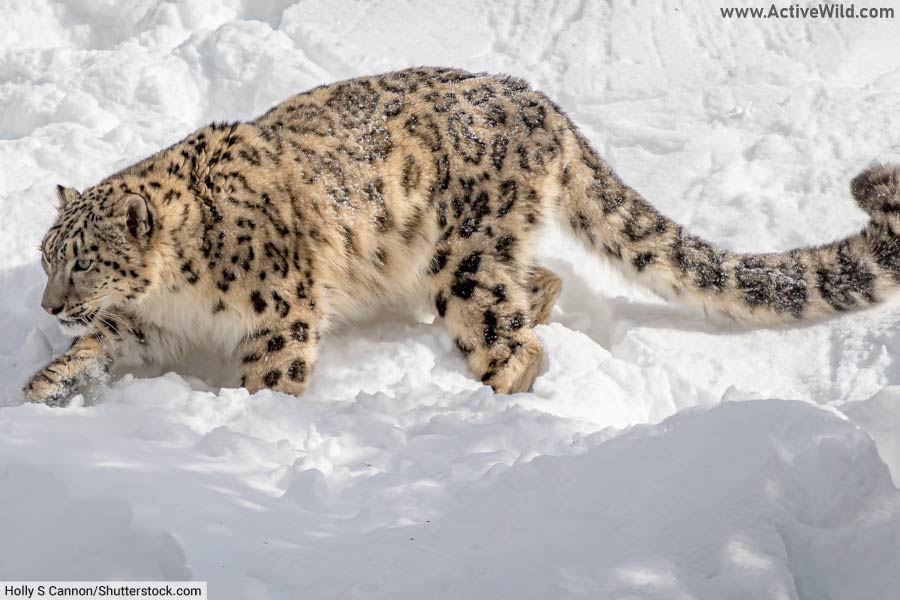
- Scientific name: Panthera uncia
- Type of animal: Mammal
- Family: Felidae
- Conservation status: Vulnerable
The snow leopard is a species of wild cat found in mountainous habitats in Central and South Asia.
The species belongs to the genus Panthera, along with the tiger, lion, jaguar and leopard, and is the only member of this group that is unable to roar.
(Being able to roar was once the distinguishing feature of the group of cats known as the “Big Cats”. Today, the snow leopard is usually included within this group.)
With a thick, white-grey coat that provides both camouflage and insulation, together with large, furry paws for walking on snow, the snow leopard is well-equipped to live and hunt on barren, snow-covered, mountainsides. Its prey includes sheep goats, and deer, with a single cat having a territory of up to 40km2.
The snow leopard is shy and rarely seen, making estimates of its population size difficult. It is thought that there are around 3,000 snow leopards left in the wild.
The snow leopard can jump both further, and higher, than any other feline. It can leap a distance of 15 meters, and as high as 6 meters.
You can find out more about the snow leopard on this page: Snow Leopard Facts
Sun Bear

- Scientific name: Herlarctos malayanus
- Type of animal: Mammal
- Family: Ursidae
- Conservation status: Vulnerable
The sun bear is the smallest of the eight living species of bear, with a shoulder height of around 70 cm (less than half of that of a large brown bear). It has a black coat, with most individuals having a prominent yellow-orange chest patch. It is this chest patch that gives the species its name.
The sun bear lives in tropical forests and shrublands in Southeast Asia. Countries in which it is found include Bangladesh, Cambodia, India, Thailand and Vietnam. It may also be present in China.
The species has an arboreal (tree-dwelling) lifestyle; more so than any other bear, including the American black bear.
Like most other bears, the sun bear is an omnivore. Its diet consists of insects such as termites, ants, and various larvae, fruits and other plant material, and occasionally, vertebrates.
Another name for the sun bear is the ‘honey bear’, due to the species’ penchant for breaking into bees’ nests for the honey inside.
The sun bear is able to mimic facial expressions, a trait that is usually only found in primate species such as gorillas.
You can find out more about the sun bear on this page: Sun Bear Facts
Tiger
- Scientific name: Panthera tigris
- Type of animal: Mammal
- Family: Felidae
- Conservation status: Endangered
The tiger is the largest member of the cat family, Felidae. Despite being one of the world’s most recognizable animals, the tiger’s wild population consists of under 3,200 adult individuals.
Tigers are able to live in a wide range of habitats, including both tropical and boreal forests.
Most wild tigers are found in southern Asia, although a separate population exists in Siberia.
Despite its endangered status, the tiger is still illegally hunted, both for its skin and for other body parts, which are used in traditional Asian medicine.
- You can find out more about tigers on this page: Tiger Facts
- You can read stories featuring tigers in our Tales From The Brink endangered animal story books
Water Buffalo
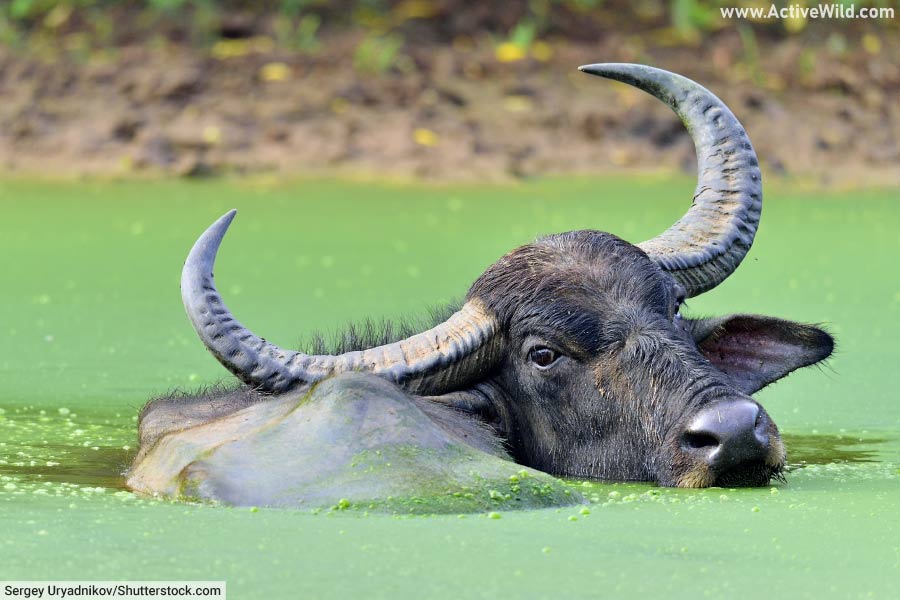
- Scientific name: Domestic water buffalo: Bubalus bubalis / Wild water buffalo: Bubalus arnee
- Type of animal: Mammal
- Family: Bovidae
- Conservation status: Domesticated / Endangered
The water buffalo, also known as the Asian water buffalo, is a common domestic animal in Asia and many other parts of the world.
The species is thought to have evolved from the wild water buffalo, Bubalus arnee., a species that is now endangered and found in scattered locations in South and Southeast Asia.
Both the wild and the domestic water buffalo belong to the cattle family, Bovidae. This group is home to domestic cattle and other hooved animals such as antelopes, buffaloes and yaks.
The water buffalo has numerous uses, including pulling farm machinery and providing milk and meat.
You can find out more about the water buffalo on this page: Water Buffalo Facts
(Wild) Bactrian Camel
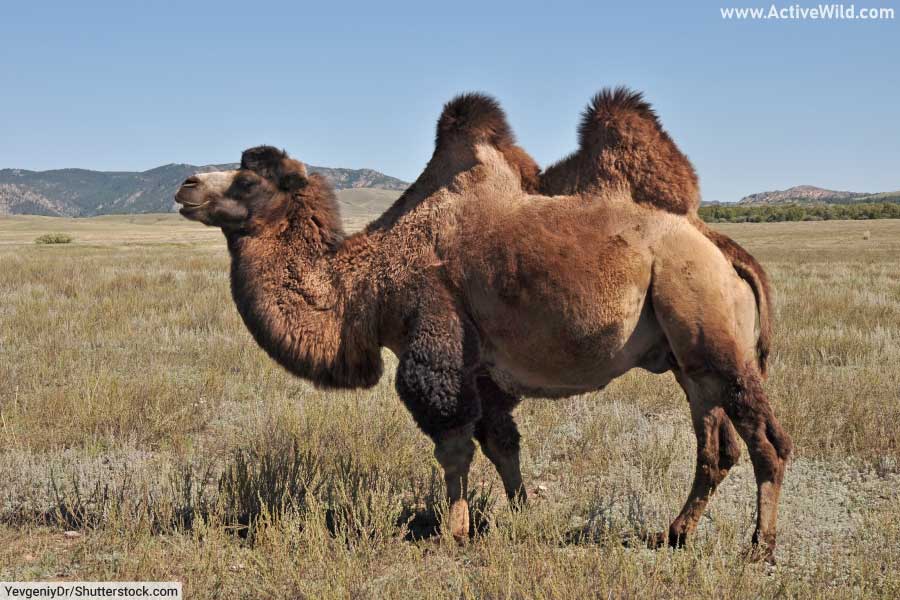
- Scientific name: Camelus ferus
- Type of animal: Mammal
- Family: Camelidae (the camel family)
- Conservation status: Critically Endangered
The wild Bactrian camel is a member of the camel family, Camelidae. This family is home to camels and related animals such as llamas and alpacas.
The wild Bactrian camel is a close relative of the Bactrian camel, an Asian animal first domesticated by humans at least 4,000 years ago.
Both the wild and domesticated Bactrian camels have two humps, unlike the third member of genus Camelus, the dromedary, which has only one hump.
Unlike its domesticated and relatively common relative, the wild Bactrian camel is critically endangered, with a population of only around 950 individuals. It lives in the steppes of Central Asia, and is found in Mongolia and China.
You can find out more about the Bactrian camel on this page: Bactrian Camel Facts
Yak
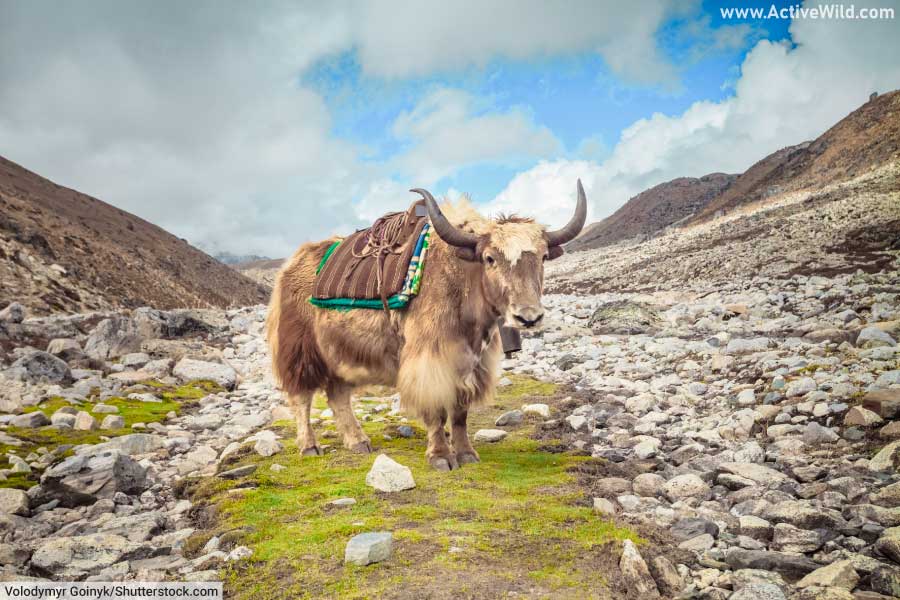
- Scientific name: Domestic yak: Bos grunniens; Wild yak: Bos mutus
- Type of animal: Mammal
- Family: Bovidae
- Conservation status: Domesticated / Vulnerable
Like the water buffalo, there is both a domestic and a wild yak. The domestic yak is one of Asia’s most iconic animals. It is a powerfully-built animal, and is both ridden and used to pull farm machinery.
The yak has numerous adaptations for living at high altitudes, including large lungs, and blood capable of transporting a high amount of oxygen.
The yak was domesticated several thousand years ago. It is descended from the wild yak, which is still found in alpine grasslands and tundra in China and India. The wild yak has a conservation status of Vulnerable; under ten thousand individuals are thought to remain in the wild.
Yaks have extremely dense coats and specialized horns that allow them to break though the thickest snow and ice to forage for food.
Yaks usually give birth to a single calf in the height of summer when conditions are at their mildest. The calf is up and walking within 10 minutes, ready to keep moving with the rest of the herd.
You can find out more about the yak on this page: Yak Facts



these asian animals are so cute but it is sad that some of them are endangered and of them are still with use today so we should help them to keep them safe from people that wants to hurt them I wrote about the asian elephant and they are endangered that they are dying from people killing them that for their tusks and that is not right to do to a animals like the asian elephant